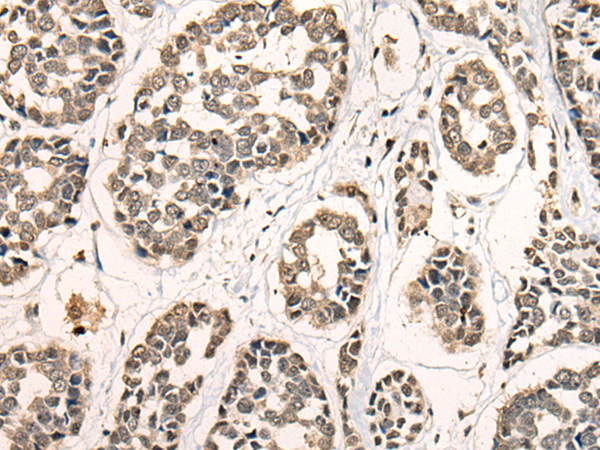

| WB | 咨询技术 | Human,Mouse,Rat |
| IF | 咨询技术 | Human,Mouse,Rat |
| IHC | 1/25-1/100 | Human,Mouse,Rat |
| ICC | 技术咨询 | Human,Mouse,Rat |
| FCM | 咨询技术 | Human,Mouse,Rat |
| Elisa | 1/5000-1/10000 | Human,Mouse,Rat |
| Aliases | BAZF; ZNF62; ZBTB28 |
| WB Predicted band size | 51 kDa |
| Host/Isotype | Rabbit IgG |
| Antibody Type | Primary antibody |
| Storage | Store at 4°C short term. Aliquot and store at -20°C long term. Avoid freeze/thaw cycles. |
| Species Reactivity | Human, Mouse |
| Immunogen | Fusion protein of human BCL6B |
| Formulation | Purified antibody in PBS with 0.05% sodium azide and 50% glycerol. |
+ +
以下是关于BCL6B抗体的参考文献示例(注:部分信息为示例性概括,具体文献需根据实际检索确认):
---
1. **文献名称**: "BCL6B suppresses tumor progression in colorectal cancer by promoting p53 signaling"
**作者**: Liu, Q., et al. (2016)
**摘要**: 本研究利用BCL6B特异性抗体通过免疫组化(IHC)和Western blot分析,发现BCL6B在结直肠癌组织中表达下调,其过表达通过激活p53通路抑制肿瘤细胞增殖和转移。
2. **文献名称**: "BCL6B regulates T follicular helper cell differentiation and humoral immune responses"
**作者**: Wang, Y., et al. (2019)
**摘要**: 通过流式细胞术和免疫沉淀(IP)结合BCL6B抗体,揭示了BCL6B在调控滤泡辅助T细胞(Tfh)分化中的关键作用,缺失BCL6B导致抗体介导的免疫应答受损。
3. **文献名称**: "The role of BCL6B in hepatic stellate cell activation and liver fibrosis"
**作者**: Zhang, H., et al. (2020)
**摘要**: 研究使用BCL6B抗体进行免疫荧光染色和Western blot,证明BCL6B在肝纤维化模型中高表达,并通过调控TGF-β信号通路促进肝星状细胞活化。
4. **文献名称**: "BCL6B mediates transcriptional repression in cooperation with HDAC complexes"
**作者**: Tanaka, T., et al. (2017)
**摘要**: 通过染色质免疫共沉淀(ChIP)和Co-IP实验结合BCL6B抗体,发现BCL6B作为转录抑制因子与组蛋白去乙酰化酶(HDAC)复合物相互作用,共同调控靶基因沉默。
---
建议通过PubMed、Web of Science等数据库以“BCL6B antibody”和“BCL6B function”为关键词检索获取具体文献。
The BCL6B antibody is a critical tool for studying the BCL6B protein, a transcriptional repressor encoded by the *BCL6B* gene. BCL6B, a paralogue of BCL6. belongs to the BTB/POZ zinc-finger protein family and regulates gene expression by recruiting chromatin-modifying complexes. It plays roles in immune regulation, cell differentiation, and apoptosis, particularly in lymphoid tissues. Dysregulation of BCL6B has been implicated in cancers, including B-cell lymphomas and solid tumors, where it may act as a tumor suppressor or oncogene depending on context.
The BCL6B antibody enables detection and quantification of BCL6B protein in techniques like Western blotting, immunohistochemistry (IHC), and immunofluorescence (IF). Its development typically involves immunizing hosts with peptide antigens derived from conserved BCL6B regions, followed by purification and validation for specificity (e.g., using knockout cell lines). Researchers utilize this antibody to explore BCL6B's role in disease mechanisms, therapeutic resistance, and its interplay with signaling pathways like NF-κB.
Challenges include cross-reactivity with BCL6 due to structural homology, necessitating rigorous validation. Optimizing protocols for tissue fixation and antigen retrieval is crucial for IHC applications. As BCL6B gains attention in precision oncology, its antibody remains vital for advancing biomarker discovery and targeted therapy research.
×